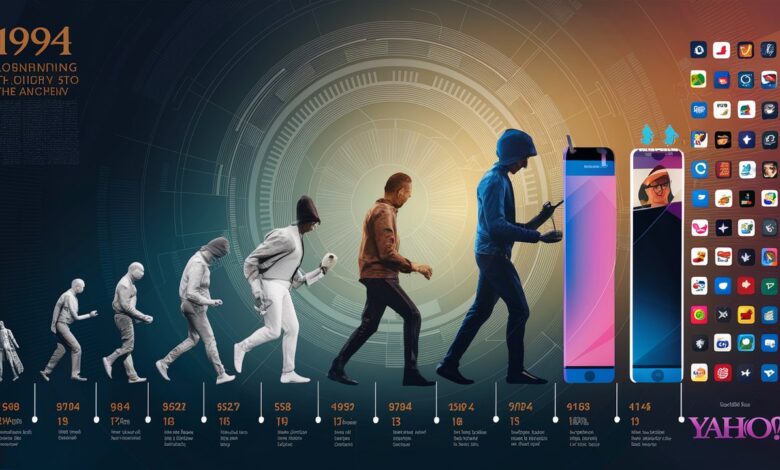The Evolution and Enduring Legacy of Yahoo: From Internet Pioneer to Modern Digital Hub

Introduction
Yahoo stands as a foundational pillar in the digital landscape, embodying the explosive growth and transformative shifts of the internet era. Founded in 1994 by Jerry Yang and David Filo as “Jerry and David’s Guide to the World Wide Web,” Yahoo evolved from a humble directory into a global powerhouse that redefined how users accessed information, communicated, and engaged with online content. At its zenith, Yahoo was synonymous with the internet itself—a portal offering search, email, news, finance, and community features to hundreds of millions. Despite fierce competition and strategic missteps, Yahoo’s resilience has cemented its legacy as a cultural and technological trailblazer. This article explores Yahoo’s journey, dissecting its innovations, challenges, and current relevance in an era dominated by tech titans like Google and Meta.
The Genesis: Yahoo’s Founding and Early Dominance
Yahoo’s origin story is steeped in the organic, chaotic energy of the early web. Stanford PhD candidates Yang and Filo curated a directory of their favorite websites to navigate the internet’s burgeoning sprawl. By 1995, this manual catalog evolved into “Yahoo!”—a backronym for “Yet Another Hierarchical Officious Oracle.” Its human-edited approach contrasted with algorithmic search, offering curated discovery when the web felt like uncharted territory. Yahoo’s IPO in 1996 ignited the dot-com frenzy, with shares soaring 154% on day one. The platform rapidly expanded beyond directories, launching Yahoo Mail (1997), Yahoo News, and Yahoo Finance, becoming a “one-stop shop” that captivated 200 million users by 2000. This era established Yahoo not just as a tool, but as a digital homeland where users lived their online lives.
The Portal Strategy: Yahoo’s Ecosystem of Services
Yahoo’s core innovation was its portal model—a cohesive ecosystem integrating diverse services under one umbrella. Yahoo Mail revolutionized communication with free, web-based email; Yahoo Finance became indispensable for real-time market data; and acquisitions like GeoCities (1999) and Flickr (2005) fostered user-generated content communities. Yahoo Messenger defined instant messaging for a generation, while its editorial teams curated news and sports content, blending human expertise with aggregation. This strategy prioritized stickiness: users logged in for email and stayed for headlines, stock quotes, or chat rooms. By 2008, Yahoo attracted over 500 million monthly visitors, demonstrating the power of integrated digital experiences long before “super apps” entered the lexicon.
Critical Crossroads: Missed Opportunities and Strategic Errors
Yahoo’s decline is often attributed to seismic missed opportunities. In 1998, it had the chance to acquire Google’s nascent search technology for $1 million but declined, viewing Google as a vendor rather than a rival. By 2006, it again hesitated to buy Facebook for $1 billion, underestimating social networking’s potential. Internally, frequent CEO turnover (six leaders between 2007–2017) bred inconsistent vision, while competitors outpaced its search technology. Google’s algorithmic precision lured advertisers, and Yahoo’s reliance on display ads faltered as programmatic advertising rose. A failed Microsoft acquisition bid in 2008 epitomized its turbulence, exposing valuation disputes and leadership indecision that eroded shareholder trust.
Verizon Media Era: Restructuring and Reinvention
After years of stagnation, Verizon acquired Yahoo’s core business in 2017 for $4.48 billion, merging it with AOL to form “Oath” (later renamed Verizon Media). This era prioritized streamlining—sunsetting neglected products like Yahoo Answers—while doubling down on media (Yahoo Sports, Finance) and programmatic advertising via Yahoo Gemini. Under CEO Guru Gowrappan, Yahoo invested in AI-driven personalization and video content, leveraging Verizon’s 5G infrastructure. Though user growth plateaued, Yahoo retained a loyal base: Yahoo Mail still serves 225 million users, while Finance averages 74 million monthly visitors. The 2021 sale of Verizon Media to Apollo Global Management for $5 billion marked a new chapter, focusing on profitability over scale.
Modern Yahoo: Core Strengths and Niche Relevance
Today’s Yahoo thrives by specializing rather than competing head-on with giants. Yahoo Finance dominates financial news, offering premium tools like portfolio tracking and live market analysis. Yahoo Mail integrates AI-powered spam filtering and productivity features, while Yahoo Sports provides real-time scores and fantasy leagues. Its news division leverages partnerships with Reuters and AP, emphasizing credibility in an age of misinformation. Advertising remains revenue-critical, with Yahoo’s demand-side platform (DSP) enabling targeted ad buys across its properties. Though no longer a “gatekeeper,” Yahoo serves users seeking trustworthy vertical-specific services—a testament to adaptive survival.
Cultural Legacy: Yahoo’s Indelible Impact
Beyond metrics, Yahoo democratized the internet. It introduced mainstream audiences to email (Yahoo Mail), community forums (Yahoo Groups), and user-generated content (GeoCities), fostering early social ecosystems. Its playful brand identity—the iconic yodel logo and purple aesthetic—symbolized the web’s joyous unpredictability. Technologically, Yahoo pioneered cloud infrastructure via Hadoop, an open-source framework for big data processing. While platforms like Facebook eclipsed its social features, Yahoo’s ethos of accessibility persists: it made the internet feel welcoming, not esoteric, for millions worldwide.
Conclusion
Yahoo’s narrative mirrors the internet’s own evolution: explosive growth, disruptive competition, and resilient adaptation. Though dethroned as the web’s top destination, it endures by refining its strengths—finance, mail, sports, and news—within targeted niches. Its legacy as an innovator is undeniable, having shaped email culture, digital advertising, and online community building. In an age of fragmented attention, Yahoo’s lesson is clear: longevity demands both visionary ambition and pragmatic evolution. For users who grew up with its purple branding, Yahoo remains a nostalgic anchor; for new generations, it’s a specialized tool in a broader digital toolkit. Its story isn’t one of obsolescence, but of metamorphosis.
Frequently Asked Questions (FAQs)
Q1: What is Yahoo best known for today?
Yahoo retains dominance in email (Yahoo Mail) and financial content (Yahoo Finance). Its finance platform is a top global destination for stock data, business news, and investment tools, while Yahoo Mail remains among the world’s largest email services. Niche offerings like Yahoo Sports and fantasy leagues also maintain dedicated user bases.
Q2: Who currently owns Yahoo?
Since 2021, Yahoo’s parent company is Apollo Global Management, which acquired Verizon Media (including Yahoo and AOL) for $5 billion. It operates under the newly formed entity Yahoo Inc., distinct from Altaba (which held Yahoo’s Alibaba shares post-Verizon sale).
Q3: Why did Yahoo decline compared to Google?
Yahoo underestimated search’s strategic value, relying on partnerships instead of developing proprietary technology. Google’s algorithmic superiority delivered faster, more accurate results, attracting users and advertisers. Yahoo’s internal turmoil and failure to innovate in search, mobile, and social media accelerated its decline.
Q4: Is Yahoo Mail still relevant?
Absolutely. Yahoo Mail serves 225 million active users, offering robust features like 1TB storage, AI spam filters, and integrations with calendars and cloud services. It remains a top-five global email provider, appealing to users seeking alternatives to Gmail or Outlook.
Q5: What happened to iconic Yahoo services like Groups or Answers?
Verizon discontinued Yahoo Answers in 2021 and Yahoo Groups in 2019 (deleting all content). These products struggled to compete with modern Q&A platforms (Quora, Reddit) and social networks. Yahoo now focuses on core verticals: finance, mail, sports, and news.
Q6: Does Yahoo still innovate?
Yes, but selectively. Recent developments include AI enhancements in Yahoo Mail (smart replies, security), immersive ad formats in Yahoo Finance, and video streaming partnerships for sports. Innovation targets profitability in high-traffic niches rather than broad disruption.



